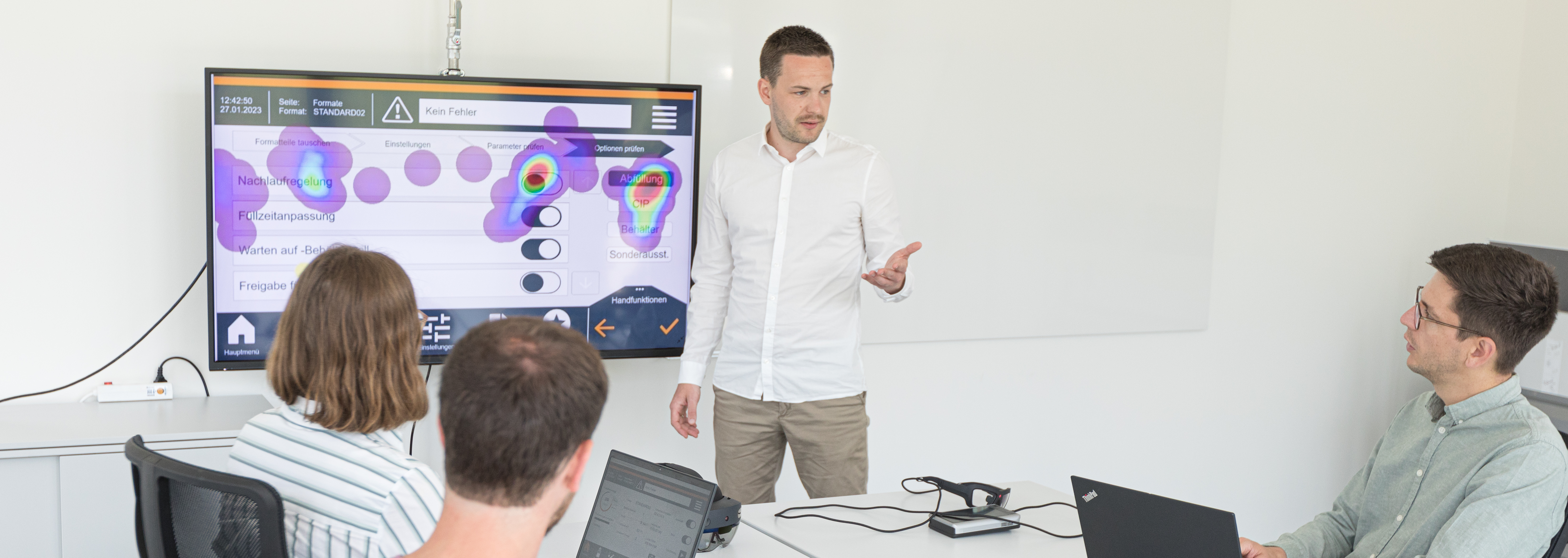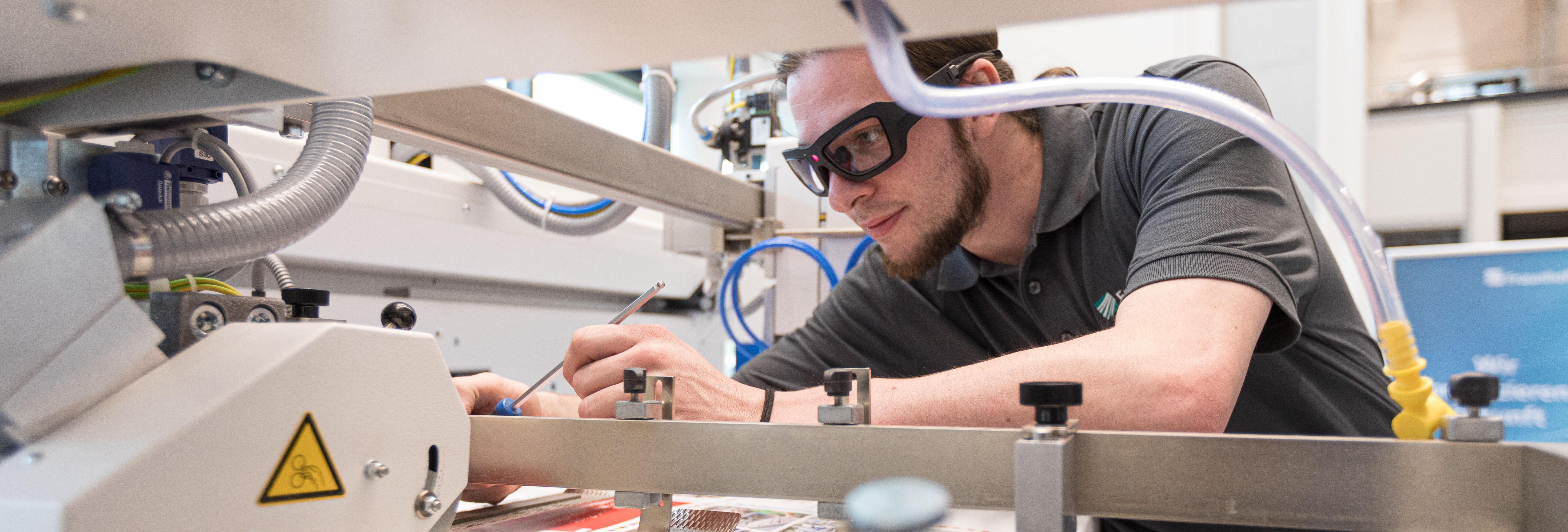
Smart manufacturing processes

Future-proof technical systems require a human-centered approach. The increasing complexity and digitalization of systems is making user-friendly operation more and more important. Intuitive operation gives manufacturers a competitive advantage, particularly as increasing numbers of untrained personnel work with complex systems.
This switch to greater system complexity with low operational experience is placing new requirements on the user interface (HMI). Simple and intuitive operation is crucial to sales success and reduces incorrect operation, increases user-friendly design and reduces the cost of operation and training.
Implementing user-friendly, effective and efficient operation is a key component in the development of future-proof systems. We will be delighted to support you throughout the process or in subprocesses when developing user-friendly, future-proof systems.
Our solutions in detail
Usability Quick Check

The human-machine interface (HMI) is the central interface between the user and the machine. The efficiency and effectiveness of machine operation and the satisfaction of users is fundamentally dependent on the design and structure of the HMI. An evaluation of usability is crucial to identifying findings and developing appropriate measures.
In usability quick checks, your company can evaluate the usability of your machinery, equipment and products with experts from Fraunhofer IPA.
Following an initial, general workshop aimed at understanding the system and the individual usability issues, a specific test scenario is developed. The right method for your application is selected in a joint process. Through usability tests and eye tracking, your system is evaluated with independent test personnel, either in our HMI laboratory, at your site or remotely. The evaluation of results and the recommended actions are then provided by the experts from Fraunhofer IPA.
We will be delighted to discuss your individual tasks, challenges or issues with you, either in person or over the phone. If you are interested, contact us for a usability quick check.
Industries:
- Mechanical and plant engineering
- Robotics
- Medical engineering
Task-based operating concepts

Users operate a machine with the support of the human-machine interface (HMI). HMIs are the central interface between the user and machine. However, these interfaces are often developed from a technical perspective and have little connection to the user’s working processes. This makes it difficult for untrained and new personnel in particular to learn how to operate the machine correctly.
One solution is to develop task-based operating concepts. These operating concepts focus on the user’s tasks, rather than the machine functionality. When developing task-based operating concepts, the first step is to undertake a detailed analysis of the working processes and the individual tasks. This may be supported with the use of a mobile eye tracking system, for example. The next step is to transfer the findings into workflows. These undergo further iteration and are then implemented on a prototype basis as an interaction design. The last step is to evaluate the system on the basis of usability tests.
We will be delighted to discuss your individual tasks, challenges or issues with you, either in person or over the phone. If you are interested in task-based operating concepts, contact us now.
Industry 4.0 in manufacturing

In the context of digitalization and demographic change, customer requirements for products are changing. This change is expressed through an increasing requirement for personalized products and an expectation that the purchase will be made “at the click of a mouse.” The impact can be felt not only in society, but also increasingly in industry and manufacturing. Companies are making greater efforts to implement digital processes (Industry 4.0) in order to stay competitive and retain the ability to respond flexibly to changes in the economy and among customers.
However, this implementation process is proceeding at different speeds in different industries. Many industries that are characterized by a large number of medium-sized enterprises sometimes find it difficult to keep pace with the change process and to offer innovative, digital products and services in line with industry trends.
Particularly in the manufacturing sector, many companies are failing to make the most of the potential offered by digitalization. The role played by the flow of information at the machine level is often significantly underestimated. But with the information and transparency gained, companies can harness the optimization potential that was previously unknown and can respond to changes more quickly and with a stronger focus on requirements.
Web-based HMI architecture

Digitalization offers a significant advantage when it comes to competitiveness and innovation in mechanical and plant engineering. To harness the benefits of digitalization, companies must make their production processes more efficient, flexible and transparent. In this context, the human-machine interface (HMI) plays an important role in making it easier to operate and monitor the machinery and plants. As such, the development of HMIs requires a great deal of work and specific expertise. Traditional HMI development environments are mostly associated with specific operating systems, hardware and protocols, which limits the flexibility, scalability and serviceability of the HMIs. In addition, they are often expensive, complex and difficult to learn.
Modern, web-based HMIs, which are created with web technologies such as HTML5, CSS and JavaScript, are therefore potential solutions for reducing the costs of visualization and increasing independence from proprietary systems. These enable a cross-platform, responsive and high-performance visualization of the operating interface, which is accessible via a web browser. Web-based HMIs are also independent of operating systems and hardware and can be displayed on a range of devices. Secure and reliable communication can be established between the control architecture and HMI architecture via standardized interface communication, such as with OPC UA. Web-based HMIs in conjunction with a standardized communication interface (such as OPC UA) are therefore a promising solution for companies in mechanical and plant engineering, offering an efficient, user-friendly, flexible and high-quality visualization of machinery and plants at a reduced cost.
We will be delighted to discuss your individual tasks, challenges or issues with you, either in person or over the phone. If you are interested in web-based HMI architectures, contact us now.
AI for production machinery and machine tools
Today, the expertise of machine operators ensures that a consistently high level of overall equipment effectiveness (OEE) is maintained in manufacturing enterprises. However, the growing shortage of skilled workers means these experts are increasingly unavailable. In order to stay competitive, a high level of OEE that is independent of the user can be achieved by using intelligent assistance systems, right the way through to lights-out manufacturing.
Artificial intelligence, and machine learning methods in particular, are suitable tools in this regard. If they are to be used in an optimal way, it is necessary to combine expertise from the fields of manufacturing technology and data analysis. We see ourselves as experts in both fields and can help you to identify and leverage the potential for optimization in your manufacturing process.
Since cutting tools are usually replaced on a schedule and not in accordance with their actual level of wear, the potential value of these tools is not exploited to the full. One example from our range of solutions is therefore the automated assessment and prediction of the actual status of the tool’s cutting edge in the machine tool.
Goal: To use AI to enable to the machine to make its own decisions on tool changes based on the actual level of wear on the tool’s cutting edge.
Implementation:
- Integration of sensors in the machine tool, enabling an automated assessment of the status of the tool’s cutting edge to be implemented in way that is neutral in relation to the main time.
- Direct recording of wear: Cutting edge images and length measurements.
- Indirect recording of wear: Force, effectiveness and structure-borne sound measurements.
- Recording of measurement data throughout the tool’s service life.
- Use of machine learning methods to detect and predict the tool’s wear status based on the recorded measurement data.
Discover the benefits yourself in pilot projects and work with us to build up your own AI expertise.